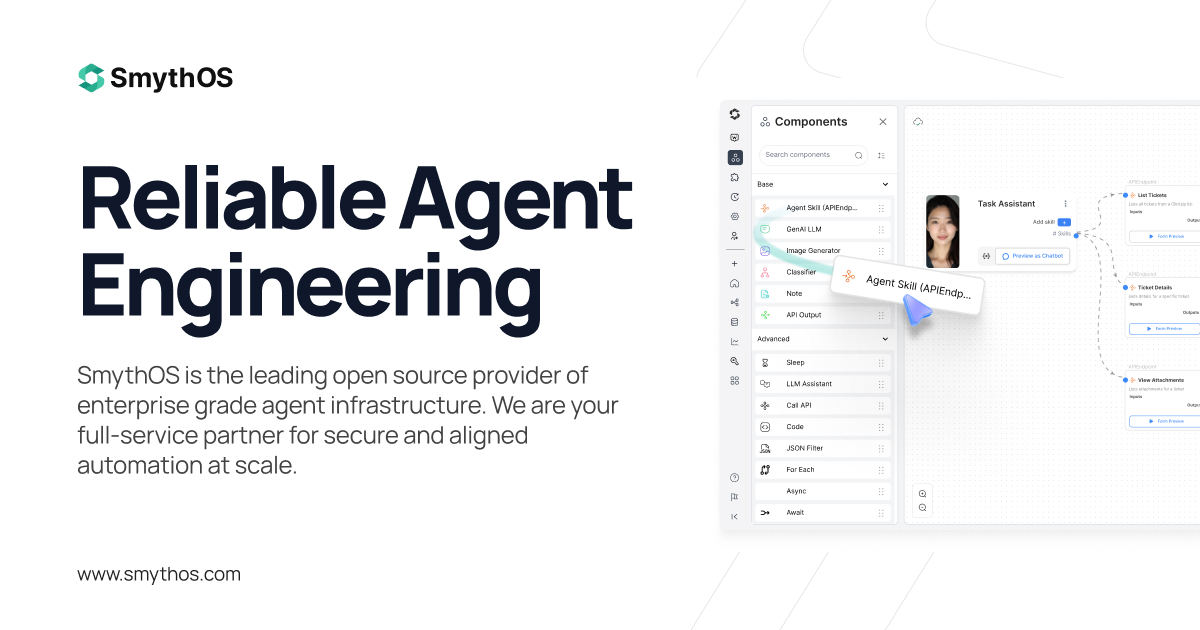
Table of Contents
Overview
SmythOS represents a groundbreaking advancement in AI agent development, having officially open-sourced its core infrastructure under the MIT License in June 2025. This comprehensive platform provides developers with everything needed to build and deploy autonomous AI agents, including the SmythOS Runtime Environment (SRE), Software Development Kit (SDK), Command-Line Interface (CLI), and extensive documentation. SmythOS is committed to fostering an open Internet of Agents, working in partnership with AGNTCY and industry leaders to establish open standards for agent interoperability.
Key Features
SmythOS delivers a robust feature set designed for enterprise-grade agent development and deployment.
- MIT open-source license: Ensures complete transparency and freedom for use, modification, and distribution under the permissive MIT License
- SmythOS Runtime Environment (SRE): Production-ready runtime specifically engineered for autonomous agent execution at scale
- Model Context Protocol (MCP) support: Native integration with the industry-standard MCP for secure tool invocation and data exchange
- Multi-protocol compatibility: Supports emerging agent communication standards including Agent-to-Agent Protocol (A2A), Agent Gateway Protocol (AGP), and Agent Communication Protocol (ACP)
- Comprehensive SDK and CLI tools: Full development toolkit with unified resource abstraction across cloud providers and services
- Enterprise security framework: Built-in access control, encrypted communications, and audit logging capabilities
- Visual Agent Builder: Planned drag-and-drop interface for no-code agent development, scheduled for release later in 2025
How It Works
SmythOS operates as a complete operating system for agentic AI, providing unified resource abstraction and management. Developers utilize the SDK to create agents using the SmythOS Runtime Environment, which handles execution, scaling, and security automatically. The platform abstracts complexity by providing consistent interfaces across different service providers, whether accessing storage systems, vector databases, or large language models. Agents communicate through standardized protocols like MCP, enabling seamless integration with external tools and services. The open-source architecture encourages community contributions while maintaining enterprise-grade reliability and security.
Use Cases
SmythOS addresses diverse applications across industries and organizational scales.
- Enterprise automation workflows: Deploy AI agents for complex business process automation with built-in security and compliance features
- Multi-agent system development: Create collaborative agent networks that coordinate tasks and share information securely
- AI research and experimentation: Leverage the open-source platform for academic research and novel AI agent architectures
- Integration platform development: Build agent-enabled applications with extensive API connectivity and standardized protocols
Pros \& Cons
Advantages
SmythOS offers compelling benefits for developers and enterprises.
- Open-source transparency: MIT License ensures complete code visibility and community ownership
- Production-ready infrastructure: Enterprise-grade runtime environment with proven scalability and reliability
- Industry standard compliance: Native support for emerging agent communication protocols and security standards
- Strong ecosystem partnerships: Collaborative relationships with Cisco, Google, Microsoft, Anthropic, and IEEE researchers
- Developer-friendly tooling: Comprehensive SDK with unified abstractions simplifies complex integrations
Disadvantages
Organizations should consider these factors when evaluating SmythOS.
- Technical expertise requirements: Implementation requires solid understanding of agent architectures and distributed systems
- Evolving protocol landscape: Rapid development of agent standards may require ongoing adaptation
- Security considerations: Model Context Protocol implementations carry inherent risks including potential code execution vulnerabilities
- Limited commercial support options: Open-source model may require internal expertise for enterprise deployment
How Does It Compare?
SmythOS occupies a unique position in the 2025 AI agent development landscape, distinguished by its open-source approach and comprehensive runtime environment.
- Microsoft AutoGen: AutoGen v0.4 features a redesigned asynchronous, event-driven architecture with cross-language support and enterprise integration through Semantic Kernel. However, SmythOS provides a more comprehensive platform with visual development tools and unified resource abstraction, while AutoGen focuses primarily on multi-agent conversation orchestration within existing applications.
- LangChain and LangGraph: LangChain v0.3 with LangGraph offers powerful agent workflow orchestration and extensive integrations. SmythOS differentiates itself by providing a complete runtime environment with built-in security, scaling, and operational features, while LangChain requires developers to handle infrastructure concerns independently.
- CrewAI: CrewAI provides structured multi-agent workflows with role-based coordination, offering pricing from free tier to enterprise plans starting at \$99/month for basic usage. Unlike CrewAI’s hosted service model, SmythOS operates as an open-source platform that can be deployed across any infrastructure while maintaining compatibility with industry-standard protocols.
- Google Vertex AI Agent Builder: Part of Google Cloud’s comprehensive AI platform, Vertex AI provides enterprise-grade tools but requires commitment to Google’s ecosystem. SmythOS offers platform independence with multi-cloud support and vendor-agnostic architecture.
Final Thoughts
SmythOS represents a significant milestone in democratizing AI agent development through its open-source approach and comprehensive platform capabilities. The June 2025 MIT license release, combined with strategic partnerships with AGNTCY and major technology companies, positions SmythOS as a foundational platform for the emerging Internet of Agents. While the platform requires technical expertise and operates within rapidly evolving protocol standards, its commitment to openness, security, and interoperability makes it an invaluable resource for organizations building the next generation of AI-powered applications. The upcoming visual Agent Builder will further expand accessibility, making SmythOS a compelling choice for both technical teams and organizations seeking to leverage autonomous agents at scale.

